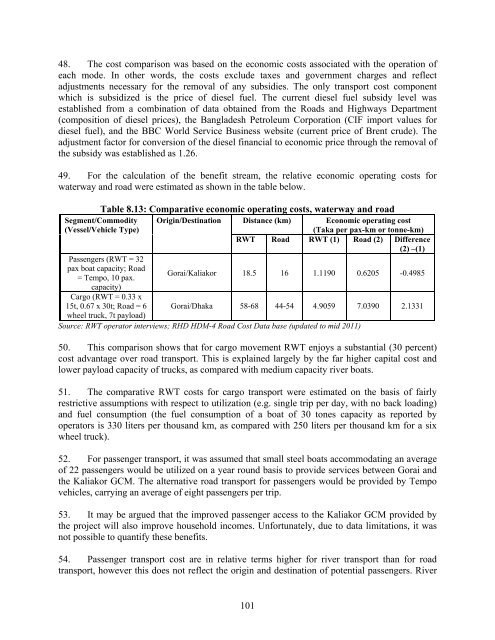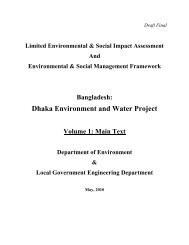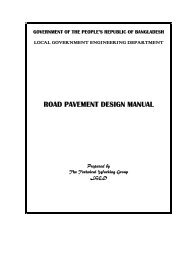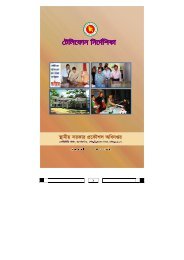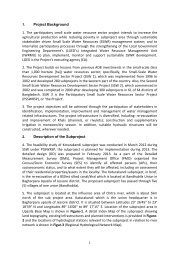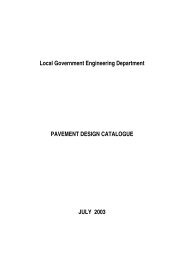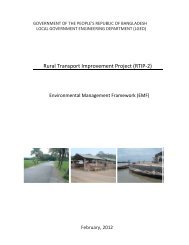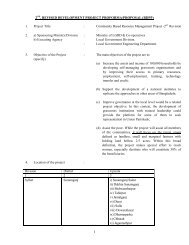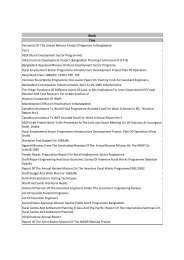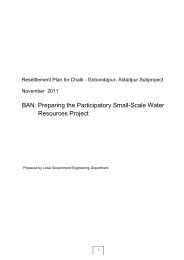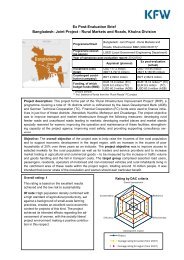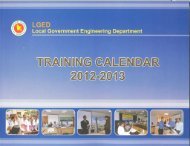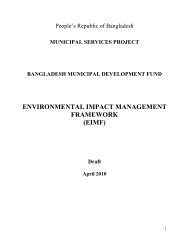PAD - LGED
PAD - LGED
PAD - LGED
You also want an ePaper? Increase the reach of your titles
YUMPU automatically turns print PDFs into web optimized ePapers that Google loves.
48. The cost comparison was based on the economic costs associated with the operation of<br />
each mode. In other words, the costs exclude taxes and government charges and reflect<br />
adjustments necessary for the removal of any subsidies. The only transport cost component<br />
which is subsidized is the price of diesel fuel. The current diesel fuel subsidy level was<br />
established from a combination of data obtained from the Roads and Highways Department<br />
(composition of diesel prices), the Bangladesh Petroleum Corporation (CIF import values for<br />
diesel fuel), and the BBC World Service Business website (current price of Brent crude). The<br />
adjustment factor for conversion of the diesel financial to economic price through the removal of<br />
the subsidy was established as 1.26.<br />
49. For the calculation of the benefit stream, the relative economic operating costs for<br />
waterway and road were estimated as shown in the table below.<br />
Table 8.13: Comparative economic operating costs, waterway and road<br />
Segment/Commodity Origin/Destination Distance (km) Economic operating cost<br />
(Vessel/Vehicle Type)<br />
(Taka per pax-km or tonne-km)<br />
RWT Road RWT (1) Road (2) Difference<br />
(2) –(1)<br />
Passengers (RWT = 32<br />
pax boat capacity; Road<br />
= Tempo, 10 pax.<br />
Gorai/Kaliakor 18.5 16 1.1190 0.6205 -0.4985<br />
capacity)<br />
Cargo (RWT = 0.33 x<br />
15t, 0.67 x 30t; Road = 6 Gorai/Dhaka 58-68 44-54 4.9059 7.0390 2.1331<br />
wheel truck, 7t payload)<br />
Source: RWT operator interviews; RHD HDM-4 Road Cost Data base (updated to mid 2011)<br />
50. This comparison shows that for cargo movement RWT enjoys a substantial (30 percent)<br />
cost advantage over road transport. This is explained largely by the far higher capital cost and<br />
lower payload capacity of trucks, as compared with medium capacity river boats.<br />
51. The comparative RWT costs for cargo transport were estimated on the basis of fairly<br />
restrictive assumptions with respect to utilization (e.g. single trip per day, with no back loading)<br />
and fuel consumption (the fuel consumption of a boat of 30 tones capacity as reported by<br />
operators is 330 liters per thousand km, as compared with 250 liters per thousand km for a six<br />
wheel truck).<br />
52. For passenger transport, it was assumed that small steel boats accommodating an average<br />
of 22 passengers would be utilized on a year round basis to provide services between Gorai and<br />
the Kaliakor GCM. The alternative road transport for passengers would be provided by Tempo<br />
vehicles, carrying an average of eight passengers per trip.<br />
53. It may be argued that the improved passenger access to the Kaliakor GCM provided by<br />
the project will also improve household incomes. Unfortunately, due to data limitations, it was<br />
not possible to quantify these benefits.<br />
54. Passenger transport cost are in relative terms higher for river transport than for road<br />
transport, however this does not reflect the origin and destination of potential passengers. River<br />
101


